FAREWELL TO THE GOTTHARD
a final visit to one of Europe’s great mountain main lines
Switzerland - 8 to 14 August 2016 - Report by Duncan Cotterill
INTRODUCTION
The Gotthard Base Tunnel opened in June and by December all but a handful of regional passenger trains should be routed through the big hole. The railway it replaces is one of the most spectacular main lines in Europe, with heavy passenger and freight traffic and dramatic scenery. This 7-day trip was my last chance to photograph it in all its glory.This page contains the main report summarising the trip. Detailed daily observations can be found here.
See The Gotthard In Style
Undoubtedly the most stylish (and probably the most expensive) way to see the Gotthard is from the beautifully restored Wagon-Lits coaches of the Venice-Simplon-Orient Express. From December it may be one of the few remaining ways to see the line from a locomotive hauled train.11191 and 11255 were in charge of the southbound luxury train, seen here passing Giornico after descending the double spiral on the morning of 12 August 2016.
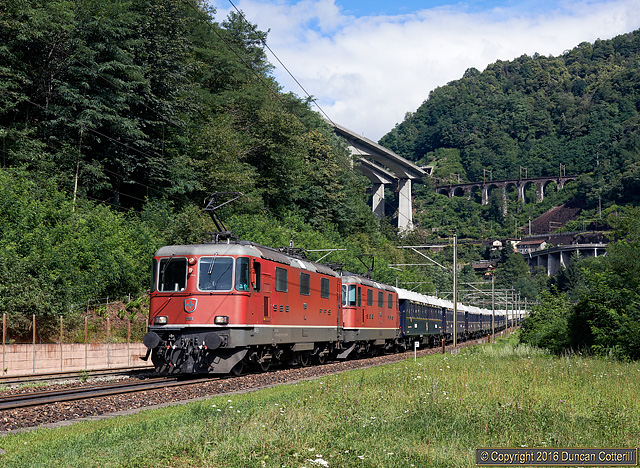
PASSENGER TRAINS
There are three regular passenger services over the Gotthard; an hourly InterCity service from Lugano to Zürich or Basel, an hourly InterRegio service from Locarno to Zürich or Basel and a two-hourly EuroCity service from Milano to Zürich. The IC and IR trains alternate between Zürich and Basel and connect at Arth-Goldau. Some early morning northbounds start from Chiasso instead of Lugano or Locarno and some evening southbounds terminate there as well.The InterCity services are classed as ICN, meaning that they’re operated by tilting EMUs, mostly SBB Class RABDe500 sets but not exclusively. TrenItalia and SBB use class ETR610 EMUs (Swiss Class RABe503) on the EuroCity services and both operators’ sets also appear on some Lugano InterCity trains as well.
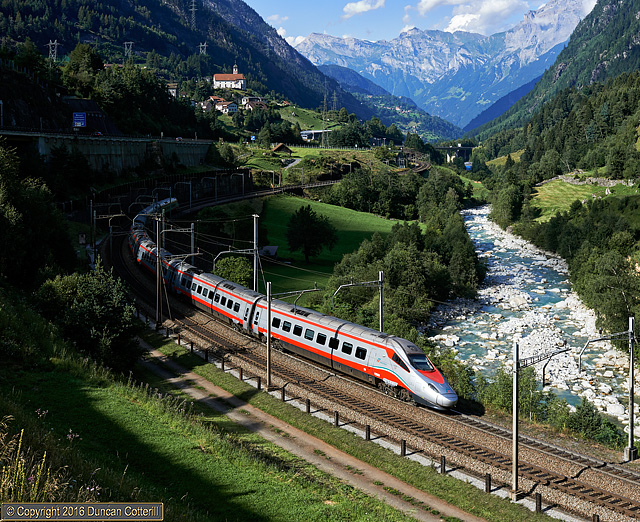
Italian Insurgent
Trenitalia’s Class ETR610 tilting EMUs are a common sight on the Gotthard along with their SBB Class RABe503 sisters. The two fleets operate the two-hourly EuroCity service between Zürich and Milano.More surprisingly, both Italian and Swiss units are used on some domestic Swiss ICN services between Basel or Zürich and Lugano, although the majority of ICNs are worked by SBB Class RABDe500 units.
610.002 in Trenitalia’s striking red and silver livery leaned into the Wattinger Curve below Wassen on 8 August 2016 while working ICN 679, the 16:04 from Basel to Lugano.
The InterRegio services are booked for loco haulage, mainly by class Re4/4II (Re420) electric locomotives although Re460s are still booked on one out and back working from/to Zürich on Saturdays and Sundays. In practice there were many more 460s around and the 420s didn’t stick to their diagrams very well. There were three occasions when an IR train from the north didn’t appear at all and the return working was handled by a Class RABe524 Flirt EMU. One of these no-shows was the train I attempted to travel on from Zürich to Göschenen at the beginning of the trip. It took an hour to stagger from Zürich to Thalwil where the train was cancelled with brake problems. All this points to Re420 reliability being very poor and the number of failures in traffic was way above anything I’ve experienced in Switzerland before.
Punctuality was also poor by Swiss standards and, unlike on previous trips, it wasn’t only trains from the south that ran late. It wasn’t uncommon to see a train from Zürich or Basel, whether loco hauled or EMU, running 10 minutes or more behind time.
Punctuality was also poor by Swiss standards and, unlike on previous trips, it wasn’t only trains from the south that ran late. It wasn’t uncommon to see a train from Zürich or Basel, whether loco hauled or EMU, running 10 minutes or more behind time.
Fast At Fusnengo
Re4/4II 11200 passed Fusnengo, south of Faido, with IR 2313, the 07:04 Basel to Locarno fast train, on 11 August 2016.Although it looks a peaceful mountain valley, this is a really noisy place with traffic screaming up and down the Autostrada behind the trees on the left.
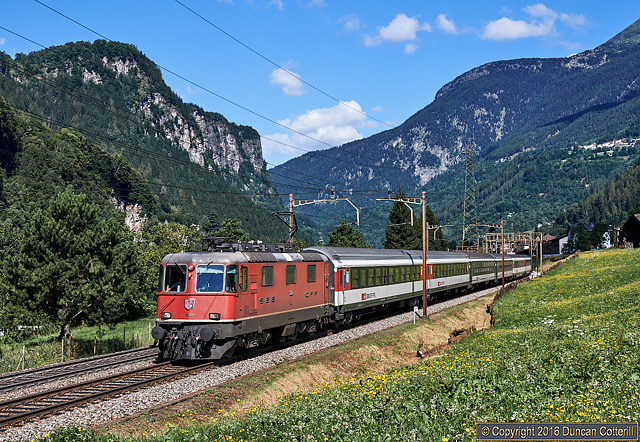
Locos seen on IR Services
11156, 11158, 11159, 11161, 11164, 11191, 11193, 11194, 11195, 11196, 11197, 11200, 11244, 11245 11247, 11251, 11255, 11258, 420.379,
460.012, 460.014, 460.017, 460.042, 460.043, 460.048, 460.069, 460.092, 460.098, 460.103.
Far more locos to cover a nominal 12 day diagram than would have been expected! Of the “celebrity” Re4/4IIs, only green 11161 was seen on the Gotthard, and then only once on the first afternoon before it disappeared. One of the SwissExpress locos, 11108 or 11109 was seen at Zürich but not on the Gotthard.
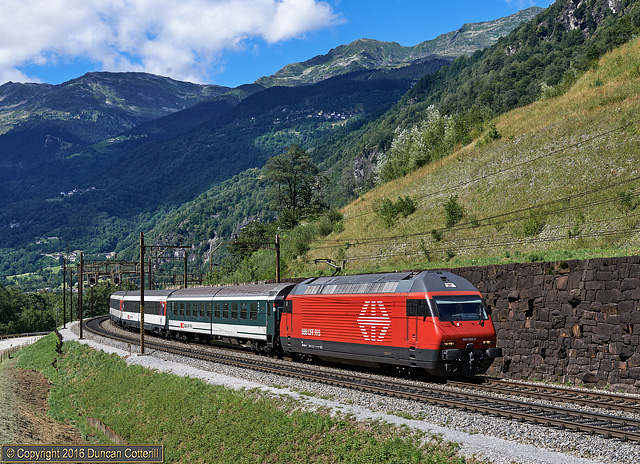
Substitute Traction
Weekday IR services over the Gotthard are supposed to be worked by Class Re4/4II electrics but it wasn’t uncommon to find Class Re460s substituting for their older cousins.460.092 passed Fedoccio, north of Lavorgo, with IR 2323, the 12:04 Basel SBB to Locarno service, on the afternoon of 12 August 2016.
There are also a few irregular services such as a pair of EC trains between Milano and Luzern and a couple of weekday EMUs extended from Biasca to Airolo or vice versa. I was expecting a number of non-timetabled reliefs to appear on the SBB website at the weekend, when the weather was good on both sides of the Alps and every train seemed well patronised. However, nothing appeared on the website, not even the one additional train that was seen, a Saturday morning northbound hauled by a 460.
South of Biasca there are regular EMU services on the main line and branches but that section of the line wasn’t visited on this occasion.
South of Biasca there are regular EMU services on the main line and branches but that section of the line wasn’t visited on this occasion.
Shades Of Things To Come
Local services in Ticino and across the border into Lombardia in Italy are worked by 4 or 6 section Stadler Flirt articulated EMUs of SBB Class RABe524 running under the TiLo brand. The units are booked to work a couple of weekday services to Airolo but also appeared at other times, sometimes substituting for failed loco hauled trains and sometimes running empty.524.111 passed Varenzo, between Rodi-Fiesso and Ambri-Piotta on one such empty working on the afternoon of 11 August 2016. When the long distance trains are diverted through the base tunnel in December, these units are expected to operate a local service over the classic mountain route.
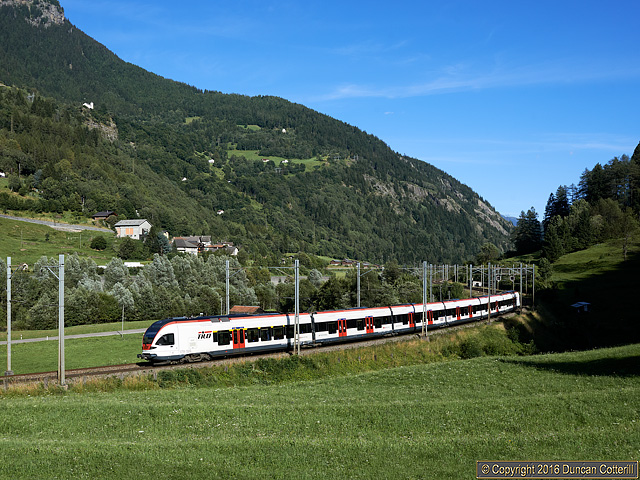
FREIGHT TRAFFIC
There wasn’t as much freight traffic as I expected and only four operators’ trains were seen, SBB Cargo, BLS Cargo, DB Cargo and Railcare. CrossRail used to operate over the Gotthard but no longer does so. It has been suggested that this is due to most of their locos not being equipped with ETCS, which is required by all trains between Brunnen and Altdorf, irrespective of whether they’re going through the new tunnel or taking the mountain line.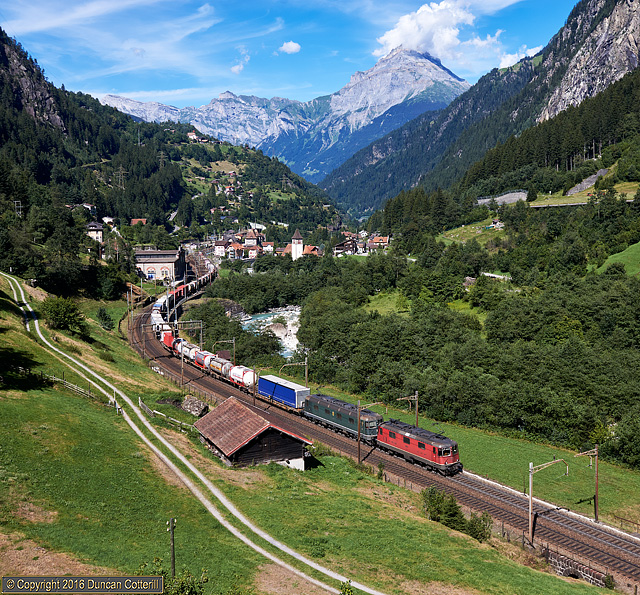
Glorious Gurtnellen
The late afternoon view of a southbound train leaving Gurtnellen must be the best on the Gotthard, with the village nestling in the Reuss Valley behind and the background dominated by the 2986m peak of Chli Windgällen.11338 and 11663 headed for the summit in glorious light on the afternoon of 13 August 2016. Almost invisible at the back, 11163 provided banking assistance. 11663 is one of the last few locos to carry the original green livery and made several appearances on the Gotthard during my week there.
Freights seen (by operator)
| Mon* | Tue | Wed | Thu | Fri | Sat | Sun* | totals | |
| BLSC | 1 | 5 | 1 | 4 | 3 | 14 | ||
| DBC | 1 | 4 | 5 | 4 | 5 | 3 | 22 | |
| railcare | 1 | 1 | 1 | 1 | 1 | 5 | ||
| SBBC | 2 | 10 | 9 | 12 | 12 | 11 | 2 | 57 |
| totals | 5 | 20 | 16 | 21 | 17 | 18 | 2 | 99 |
Freights seen (by type)
| Mon* | Tue | Wed | Thu | Fri | Sat | Sun* | totals | |
| intermodal | 3 | 11 | 9 | 14 | 7 | 15 | 1 | 60 |
| general freight | 1 | 7 | 5 | 6 | 10 | 3 | 1 | 33 |
| postal | 1 | 2 | 2 | 1 | 6 | |||
| totals | 5 | 20 | 16 | 21 | 17 | 18 | 2 | 99 |
SB Freights seen (by time at Göschenen)
| Mon* | Tue | Wed | Thu | Fri | Sat | Sun* | totals | |
| 08:30 - 09:00 | ---- | 0 | 0 | 0 | 0 | 0 | 0 | 0 |
| 09:00 - 10:00 | ---- | 0 | 0 | 1 | 0 | 0 | 0 | 1 |
| 10:00 - 11:00 | ---- | 0 | 0 | 0 | 1 | 1 | 0 | 2 |
| 11:00 - 12:00 | ---- | 0 | 1 | 2 | 1 | 1 | 0 | 5 |
| 12:00 - 13:00 | ---- | 2 | 1 | 1 | 0 | 1 | 0 | 5 |
| 13:00 - 14:00 | ---- | 2 | 0 | 1 | 0 | 2 | 0 | 5 |
| 14:00 - 15:00 | 0 | 1 | 1 | 0 | 0 | 0 | ---- | 2 |
| 15:00 - 16:00 | 0 | 0 | 0 | 1 | 1 | 1 | ---- | 3 |
| 16:00 - 17:00 | 0 | ---- | 2 | 1 | 3 | 2 | ---- | 8 |
| 17:00 - 18:00 | 1 | 1 | 1 | 2 | 0 | 1 | ---- | 6 |
| 18:00 - 19:00 | ---- | 2 | 1 | 1 | 2 | 0 | ---- | 6 |
| totals | 1 | 8 | 7 | 10 | 8 | 9 | 0 | 43 |
NB Freights seen (by time at Göschenen)
| Mon* | Tue | Wed | Thu | Fri | Sat | Sun* | totals | |
| 08:30 - 09:00 | ---- | 1 | 1 | 1 | 1 | 0 | 0 | 4 |
| 09:00 - 10:00 | ---- | 0 | 0 | 0 | 0 | 1 | 0 | 1 |
| 10:00 - 11:00 | ---- | 0 | 0 | 0 | 1 | 0 | 1 | 2 |
| 11:00 - 12:00 | ---- | 0 | 0 | 1 | 0 | 1 | 0 | 2 |
| 12:00 - 13:00 | ---- | 2 | 0 | 0 | 2 | 1 | 1 | 6 |
| 13:00 - 14:00 | ---- | 2 | 1 | 1 | 0 | 0 | 0 | 4 |
| 14:00 - 15:00 | 0 | 1 | 1 | 2 | 1 | 0 | ---- | 5 |
| 15:00 - 16:00 | 2 | 1 | 2 | 1 | 1 | 1 | ---- | 8 |
| 16:00 - 17:00 | 1 | ---- | 0 | 0 | 1 | 1 | ---- | 3 |
| 17:00 - 18:00 | 1 | 3 | 3 | 3 | 1 | 0 | ---- | 11 |
| 18:00 - 19:00 | ---- | 2 | 1 | 2 | 2 | 3 | ---- | 10 |
| totals | 4 | 12 | 9 | 11 | 10 | 8 | 2 | 56 |
---- = time spent out of sight of the line, Mon* = 4 hours observation, Sun* = 5 hours, other days 10 to 11 hours, making a total of around 60 hours, giving an average of a southbound freight every 84 minutes and a northbound every 64 minutes. Trains weren’t evenly distributed throughout the day and it wasn’t unusual to wait over 3 hours for a train in one direction or the other, or to see two freights following each other less than 10 minutes apart. These figures include general freights, intermodal and postal trains but not local departmental workings. There wasn’t much of a pattern to what ran and when, beyond saying that mornings were quieter than afternoons and Tuesday and Thursday were the busiest days. Saturday was remarkably good with more freights than either Wednesday or Friday. It is possible that some freights were running through the base tunnel but I’ve seen no evidence one way or the other.
When Less Means More
BLS Cargo operated fewer trains over the Gotthard than either SBB or DB but managed to use locos of more classes to do so. Even if you count BLS Class Re486 and the Class 186s hired from Railpool as being the same and discount the BLS Re465s hired to Railcare, there were still three different classes in use.BLS Cargo’s 485.001 & 485.009 rounded the curve at Varenzo, south of Ambri-Piotta, with a northbound intermodal on the afternoon of 11 August 2016.
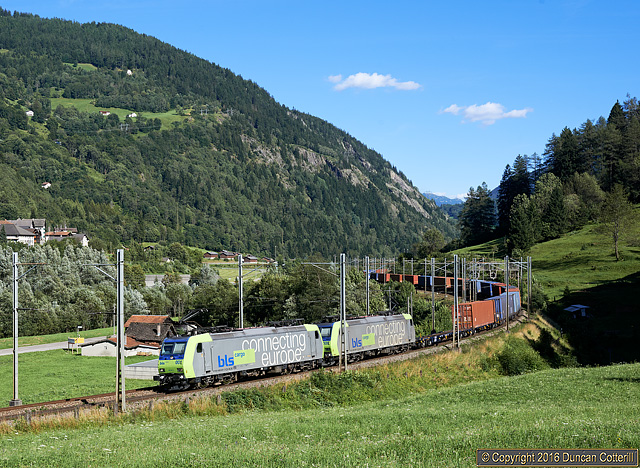
SBB Cargo operated well over half the trains seen, usually with an Re10/10 (Re4/4II+Re6/6 double headed). A handful of trains ran with a single Re4/4II, a single Re6/6 or a pair of Re4/4IIs and a few trains were banked up the north ramp by an Re4/4II. An average of one Re20/20 quadruple header was seen each day but no Re12/12s (Re4/4II triple headers) were seen. None of SBB Cargo’s newer locos of Classes Re474, Re482 or Re484 were seen. Some SBBC locos carried their old numbers, others their new numbers and many had both. I recorded whichever caught my eye as they passed, usually the old number if both were present as it was easier to see.
Almost two thirds of SBBC trains were intermodals and most of the rest were general freights. There was a postal service going south at Göschenen around 14:00 on Tuesday and Wednesday and north around 17:20 on Monday to Thursday but I didn’t see the southbound on Thursday or either train on Friday, despite being in sight of the line for hours either side of when they were expected to run.
Almost two thirds of SBBC trains were intermodals and most of the rest were general freights. There was a postal service going south at Göschenen around 14:00 on Tuesday and Wednesday and north around 17:20 on Monday to Thursday but I didn’t see the southbound on Thursday or either train on Friday, despite being in sight of the line for hours either side of when they were expected to run.
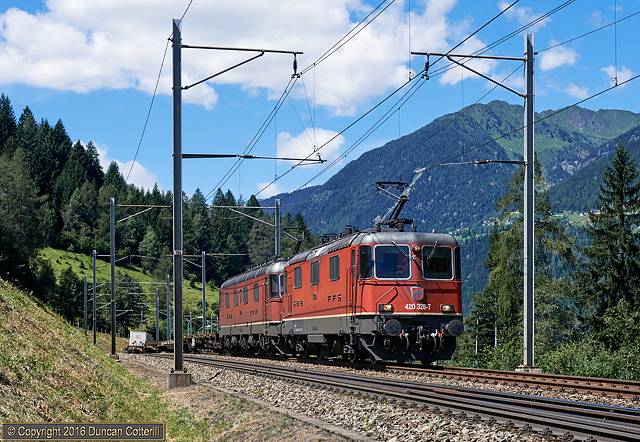
SBB Classics
The classic combination of an Re4/4II double heading with an Re6/6, known as an Re10/10, was the most common power for SBB worked freights over the Gotthard during my visit. Both classes have now served SBB for over 40 years with the earliest Re4/4IIs now approaching 50 years in traffic.11328 & 11679 were photographed at Varenzo, between Ambri-Piotta and Rodi-Fiesso, with a lightly loaded southbound intermodal on 11 August 2016. The leading loco also carries its new computerised number, 420.328-7 on both the nose and side.
SBB Cargo locos seen
11163, 11249, 11250, 11254, 11257, 11259, 420.268, 11271, 11273, 420.276, 11280, 11286, 11287, 11293, 11294, 11298, 11320, 11321, 11324, 11325, 11327, 11328, 11331, 11332, 11336, 11338, 11339, 11341, 11343, 11345, 420.346, 11348,
11603, 11605, 11607, 11614, 11616, 11624, 11625, 11629, 11634, 11636, 11639, 11657, 620.062, 11663, 11667, 11668, 11670, 11671, 620.075, 620.076, 11677, 11678, 11679, 620.081, 620.084, 11685, 620.086
La Posta
Mail trains still run on the Swiss network including a pair of daytime trains over the Gotthard, linking Harkingen, near Olten, with Cadenazzo, near Bellinzona.11254 emerged from the Wattinger Tunnel, below Wassen, with the northbound train at 17:31 on 8 August 2016.
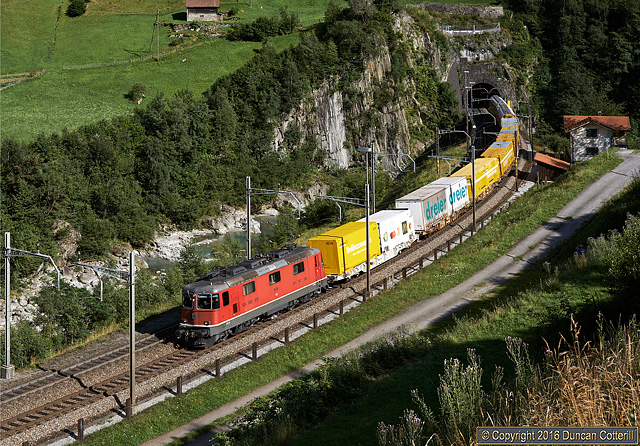
All DB Cargo freights were operated by Class 185 electrics, usually in pairs although the odd single header was seen and there was one triple header. Around 80% of DB trains were general freights with the remainder intermodals.
185.090, 185.101, 185.105, 185.109, 185.110, 185.114, 185.116, 185.117, 185.119, 185.122, 185.125, 185.127, 185.130, 185.133, 185.134, 185.136, 185.141
DB Cargo locos seen
185.090, 185.101, 185.105, 185.109, 185.110, 185.114, 185.116, 185.117, 185.119, 185.122, 185.125, 185.127, 185.130, 185.133, 185.134, 185.136, 185.141
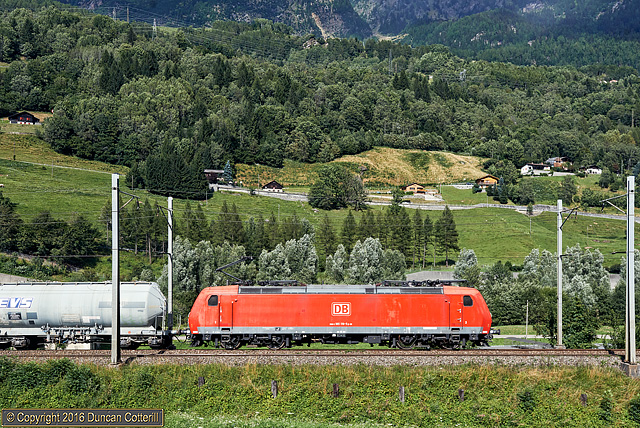
A Rarity In Its Own Way
After noting that I had seen 22 freights operated by DB Cargo during the trip, it was a surprise to find that this was the only one I’d photographed in sun. The rest had passed during cloudy periods, while I was waiting at bus stops, or had been going the wrong way at locations where there wasn’t a shot in the other direction. Even this one was going the wrong way and was only photographed because the single loco fitted between the poles.185.119 passed Varenzo, south of Ambri-Piotta, with a short freight on 10 August 2016.
BLS Cargo trains were the most variable in terms of motive power and days of operation. In addition to their own Classes Re485 and Re486, there were also Railpool registered locos of (German) classes 186 and 187. There were probably more 186s than noted here as the numbers were particularly difficult to read and most passed without being identified. No BLS Class 425 “Brownies” were seen, although several are fitted with ETCS enabling them to access the line. The number of BLS trains varied considerably from day to day, from as many as five down to zero, and that was on a weekday. Tuesday and Thursday were the busiest days for BLS.
There was a distinctive northbound intermodal carrying short white refrigerated swap bodies and hauled by a single Re465 that passed Göschenen shortly after 15:00 on Monday to Thursday. It wasn’t seen on Friday and ran almost 4 hours later on the Saturday. I’d initially assumed this was a BLS Cargo working but it seems that it was operated by Railcare, a subsidiary of the Swiss Coop. Since 2013 BLS Cargo have loaned five of their Class Re465s to Railcare and have received five Railpool Class 186s in return. This suits BLSC as they get locos equipped to work on the Italian and Dutch 3000V DC systems while Railcare also have the use of a BLS Class Re425 that can operate their trains on the 11kV equipped section from Chur to Felsberg as part of the deal.
There was a distinctive northbound intermodal carrying short white refrigerated swap bodies and hauled by a single Re465 that passed Göschenen shortly after 15:00 on Monday to Thursday. It wasn’t seen on Friday and ran almost 4 hours later on the Saturday. I’d initially assumed this was a BLS Cargo working but it seems that it was operated by Railcare, a subsidiary of the Swiss Coop. Since 2013 BLS Cargo have loaned five of their Class Re465s to Railcare and have received five Railpool Class 186s in return. This suits BLSC as they get locos equipped to work on the Italian and Dutch 3000V DC systems while Railcare also have the use of a BLS Class Re425 that can operate their trains on the 11kV equipped section from Chur to Felsberg as part of the deal.
Railcare not BLS Cargo
465.016 led a northbound intermodal around the Wattinger Kurve, below Wassen on the afternoon of 8 August 2016.The loco is one of five hired to Railcare by BLS Cargo and is seen here on a train of refrigerated swap bodies operated for the Swiss Coop from Stabio and Castione to Oensingen. This train was the closest thing seen to a regular freight on the whole trip, passing Göschenen between 15:00 and 15:30 on the Monday to Thursday. It wasn’t seen on the Friday and ran over three hours later on the Saturday.
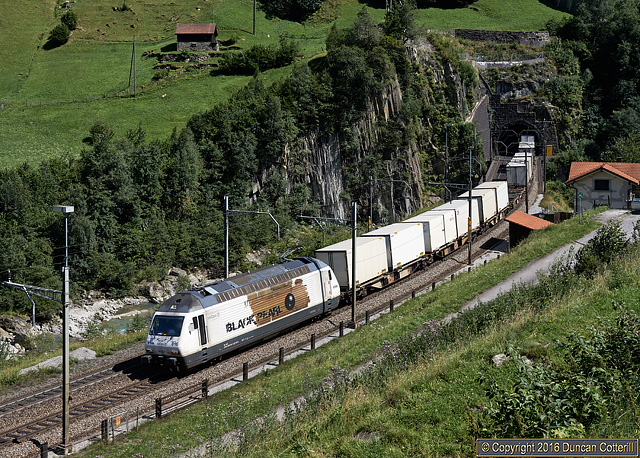
BLS Cargo locos seen
BLS 465.016, 465.018
BLS 485.001, 485.008, 485.009, 485.010
BLS 486.505, 486.507, 486.509
RPool 186.104, 186.108
RPool 187.004, 187.006
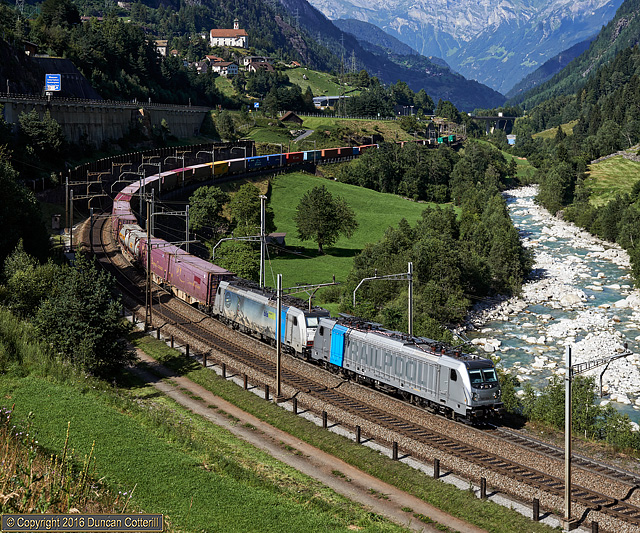
Hired Help
A good proportion of BLS freights were worked by locos hired from Railpool, a German locomotive leasing company.This shot shows two Railpool locos, 187.004 and an unidentified Class 186 negotiating the Wattinger Curve below Wassen with a southbound intermodal on 8 August 2016. The Railpool 186s were particularly hard to identify as they had black numbers cunningly camouflaged on a black and white patterned background. Once you had worked out where the number was and which of the 12 digits you needed, the loco was already too far away to read them. The numbers don’t show up well on photos either.
DEPARTMENTAL WORKINGS
In addition to the revenue earning freights noted above, a number of departmental workings were seen on the south ramp, most operated by SBB Class Am843 diesels. These included a tunnel rescue train that went south from Airolo on the afternoon of 11 August, returning north around 3 hours later. There were also a few Class Tm234 tractors scuttling around, some on their own, others dragging a single wagon.
Diesel To The Rescue
Diesel powered rescue trains are stationed on the Gotthard, just in case there’s a major incident inside one of the tunnels. They probably get bored just sitting waiting for something to happen, so every now and again the diesel takes them for a run down the mountain and back again to keep their spirits up.843.019 passed Varenzo, north of Rodi-Fiesso, with a rescue train on the afternoon of 11 August 2016. The same loco and train had passed in the opposite direction a few hours earlier.
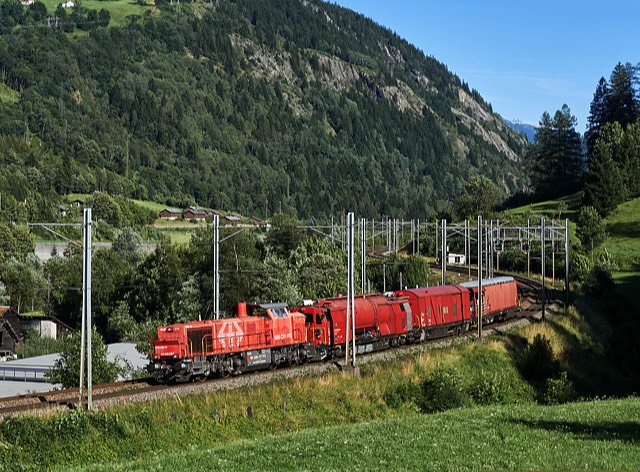
PHOTOGRAPHY
The Gotthard isn’t a particularly easy line to photograph, largely due to the peculiarities of the Swiss electrification system. The poles are very closely spaced compared to Austria or Germany, leaving gaps that are barely long enough to fit a single loco, let alone a double or quadruple header. The problem is particularly bad on curves and the Gotthard is a very curvy railway. Although I prefer photographing freights to passenger trains, the IRs made the best photographs in many locations as a single Re4/4II would fit into gaps that were too short for anything else.
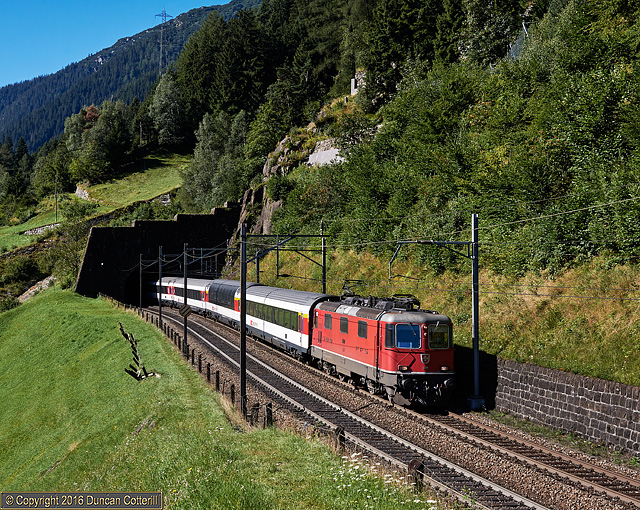
Poles Apart
The poles are just far enough apart at this spot above Wassen to fit an Re4/4II between them. I hate photographing trains with poles growing out of the loco but at many locations on the Gotthard they’re impossible to avoid and you have to work hard to avoid poles in front of the loco, let alone behind it.11191 was in charge of IR 2418, the 08:47 Locarno - Zürich InterRegio, on 14 August 2016.
The train was photographed emerging from Obere Entschigtal Galerie, which looks like a tunnel but serves more as an avalanche shelter.
Apart from the pole spacing, the line has everything required for quality photography with excellent scenic backgrounds, plenty of good, accessible vantage points and enough twists and turns to ensure that the light is right somewhere at any given time.
The best locations are largely on the north ramp but there are some good spots on the south side as well. Having only photographed north of there summit in the past, I’d intended splitting my time evenly between the two sides but ended up spending far more time on the south ramp to escape foul weather in the north. By keeping a very close eye on the weather forecasts it was possible to avoid the worst of the weather, meaning that the Tuesday was the only day I didn’t get any shots in full sun. Weather forecasts are available on the web at http://www.meteoschweiz.ch (only available in German, French or Italian) and on TV. The repeating forecast on SRF1 TV between 06:30 and 07:30 every morning is particularly useful. The times of other TV forecasts can be found at http://tvprogramm.srf.ch, just look for Meteo.
The best locations are largely on the north ramp but there are some good spots on the south side as well. Having only photographed north of there summit in the past, I’d intended splitting my time evenly between the two sides but ended up spending far more time on the south ramp to escape foul weather in the north. By keeping a very close eye on the weather forecasts it was possible to avoid the worst of the weather, meaning that the Tuesday was the only day I didn’t get any shots in full sun. Weather forecasts are available on the web at http://www.meteoschweiz.ch (only available in German, French or Italian) and on TV. The repeating forecast on SRF1 TV between 06:30 and 07:30 every morning is particularly useful. The times of other TV forecasts can be found at http://tvprogramm.srf.ch, just look for Meteo.
Two From The Road
Despite the mountainous nature of the Gotthard, there are several locations that don’t involve any climbing at all. This position is by the side of the main road just a few hundred metres from the Fedoccio bus stop, a couple of km north of Lavorgo.11684 and 11343 descended the south ramp with an intermodal at midday on 11 August 2016.
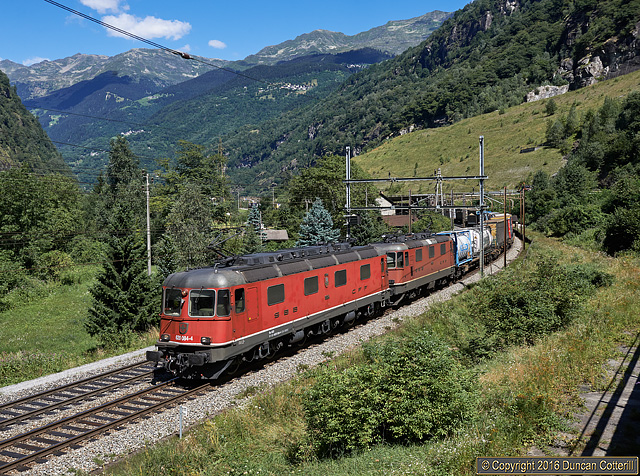
The dull weather wasn’t wasted. A poor day early in the trip was very useful for exploration and made subsequent visits to the south ramp much easier as I knew where to go. It can sometimes be more difficult to find your way to a spot than to find the spot itself. A good map is very useful but the best Swiss maps are very expensive to buy and there isn’t always a convenient shop available. The highest detail SwissTopo mapping is available online at https://map.geo.admin.ch/?lang=en, showing most farm tracks and footpaths as well as bus stops and details of the railway such as bridges, tunnels etc. Most of the buses I used had free WiFi so it was possible to check the details of how to get to the spot on the way there. Google Maps Streetview was also useful for checking the potential of various locations. The line is close to the roadside for much of the way and it’s possible to get a good idea of the state of foreground vegetation, power lines, fences backgrounds etc without leaving the comfort of your own armchair.
At many locations there’s little warning of an approaching train. You can’t see them around the sharp curves, you can’t hear them over the continuous din from the Autobahn and the signals, if you can see them, don’t change long before the train arrives. That means you’ve always got to be alert or risk missing what might be the only freight for several hours. It’s tiring enough when you’re only waiting for trains in one direction and makes it difficult to cover both directions at once.
At many locations there’s little warning of an approaching train. You can’t see them around the sharp curves, you can’t hear them over the continuous din from the Autobahn and the signals, if you can see them, don’t change long before the train arrives. That means you’ve always got to be alert or risk missing what might be the only freight for several hours. It’s tiring enough when you’re only waiting for trains in one direction and makes it difficult to cover both directions at once.
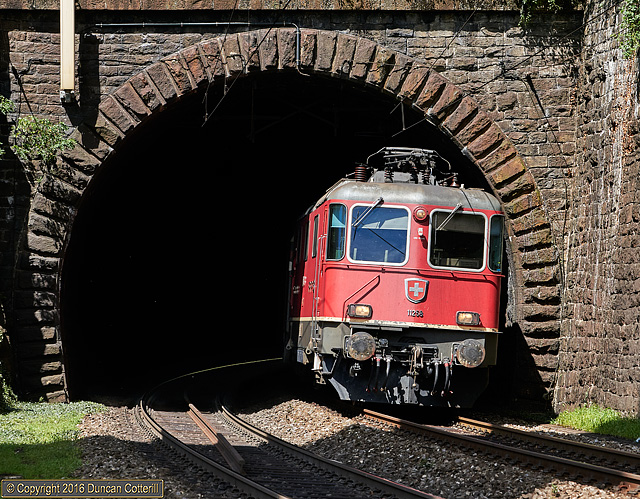
Early Warning
A train emerging from a tunnel on a curve usually doesn’t give you much warning but there was plenty of time to set up for this shot of 11258 emerging from the Galleria Tourniquet with IR 2417 on 12 August 2016.The clue is in the name of the tunnel, which is on the middle level of the double spiral between Lavorgo and Giornico. Trains approaching from the north can be seen negotiating the upper level a minute or so before they reach this spot.
GETTING AROUND
Bearing in mind that I was going to the Gotthard for a week and not planning a grand tour of Switzerland, a Swiss Pass would have been a very expensive choice and an Inter Rail not much cheaper. None of the other options, such as the Swiss Transfer ticket or Half Fare Card, made sense economically either, just buying individual tickets as I went round would have been cheaper. However there were better options.
The bus is the only practical way to get close to most of the photo locations on either side of the pass using public transport. Local train services are limited to a couple of peak hour trains on the south ramp, so are virtually useless. AAGU (Autobus AG Uri) operate an hourly bus service between Göschenen and Fluelen via Erstfeld, closely following the line. They had a daily ticket (Tageskarte) for CHF17 allowing unlimited use of their buses on this and most other routes and available to buy from the driver. More information here (in German) https://www.aagu.ch/angebot-dienstleistung/%25C3%25B6v-billette.
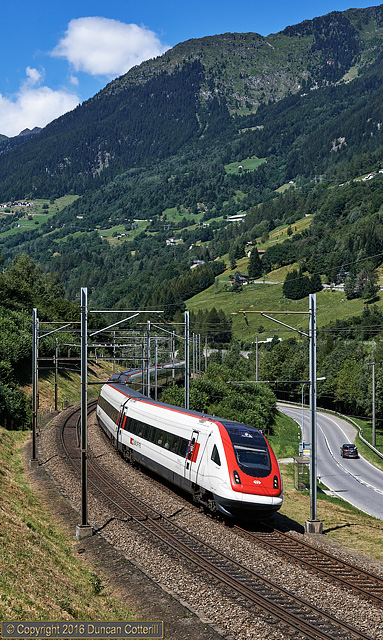
Non-Stop past the Bus Stop
ICN and EC services don’t serve any stations on the mountain section of the Gotthard, running non-stop from Arth-Goldau to Bellinzona in just over 90 minutes. 500.016 slithered round the reverse curves at Varenzo, between Ambri-Piotta and Rodi-Fiesso, with ICN 671, the 11:04 Basel SBB to Lugano express, on 11 August 2016.Fortunately the buses do stop at Varenzo, making access to the photo position straightforward. The bus stop can be seen just to the right of the unit’s cab.
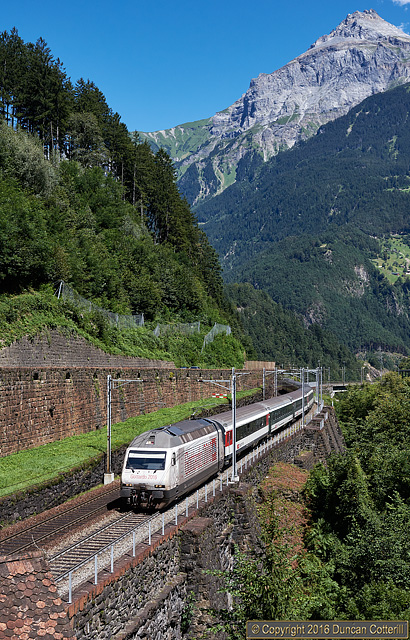
The Great Wall of Intschi
460.098, in Gottardo 2016 livery, led IR 2421, the 12:09 InterRegio from Zürich HB to Locarno, along the Great Wall, just north of Intschi, on 13 August 2016. The line clings to the mountainside high above the floor of the Reuss Valley at this point but is far from inaccessible.The shot was taken from the main road, which runs behind the section of wall above the train and is served by the hourly buses between Erstfeld and Göschenen with bus stops a few hundred metres walk in both directions.
All public transport on the south ramp, and the rest of Ticino, comes under the auspices of the Arcobaleno transport community. Arcobaleno have a series of passes and day tickets but organised on a zonal system. The zones are different for passes and day tickets, just to complicate matters. A four zone day ticket would cover unlimited use of the bus and train from Airolo to Bodio for CHF16.80 but a two zone weekly pass for the same area was only CHF35. Both day tickets and passes are valid on buses and trains within the appropriate zones.
In theory both day tickets and weekly passes are available from SBB ticket machines and bus drivers in the Arcobaleno area but it’s a bit more complicated than that. For most Arcobaleno passes you require a photo card but not for the weekly pass. However you can’t buy a weekly pass from a ticket machine or a bus driver if you don’t have a photo card. I found that out by trying and failing to get one from the ticket machine at Airolo. Fortunately the tourist information centre on the station sells tickets and the nice ladies there sold me one. It seems that the pass needs to be personalised with your name and date of birth, which is why you can’t just buy one from a machine. Lots of Arcobaleno information here (in English) https://arcobaleno.ch/en/home.
I got the weekly ticket on the basis that it would work out cheaper over the two days I intended to spend on the south side and much cheaper if I spent more time there. Hang on you’re saying, how can CHF35 be cheaper than 2 x CHF16.80. Well, if I was using day tickets, my first opportunity to buy one would be when I got on the bus at Faido, so I’d need to buy a train ticket from Göschenen, where I was staying, to Faido. With the weekly pass I only needed a train ticket to Airolo, with the pass providing the validity from there to Faido. The difference between the two train fares was more than the difference in cost between two day tickets and the weekly pass. The alternative of changing from train to bus at Airolo would have cost an hour as the bus leaves a few minutes before the train arrives and it’s a 50 minute wait until the next one. In the event I spent four days on the south side so the weekly pass was excellent value.
In theory both day tickets and weekly passes are available from SBB ticket machines and bus drivers in the Arcobaleno area but it’s a bit more complicated than that. For most Arcobaleno passes you require a photo card but not for the weekly pass. However you can’t buy a weekly pass from a ticket machine or a bus driver if you don’t have a photo card. I found that out by trying and failing to get one from the ticket machine at Airolo. Fortunately the tourist information centre on the station sells tickets and the nice ladies there sold me one. It seems that the pass needs to be personalised with your name and date of birth, which is why you can’t just buy one from a machine. Lots of Arcobaleno information here (in English) https://arcobaleno.ch/en/home.
I got the weekly ticket on the basis that it would work out cheaper over the two days I intended to spend on the south side and much cheaper if I spent more time there. Hang on you’re saying, how can CHF35 be cheaper than 2 x CHF16.80. Well, if I was using day tickets, my first opportunity to buy one would be when I got on the bus at Faido, so I’d need to buy a train ticket from Göschenen, where I was staying, to Faido. With the weekly pass I only needed a train ticket to Airolo, with the pass providing the validity from there to Faido. The difference between the two train fares was more than the difference in cost between two day tickets and the weekly pass. The alternative of changing from train to bus at Airolo would have cost an hour as the bus leaves a few minutes before the train arrives and it’s a 50 minute wait until the next one. In the event I spent four days on the south side so the weekly pass was excellent value.
Running Wrong Line
The Gotthard is signalled for reversible working and it’s often used to allow overtaking. 11258 emerged from the Mittlere Entschigtal Galerie into Wassen station on the wrong line with IR 2320 on 14 August 2016. The late running 09:47 Locarno - Basel had just been overtaken by the even later EC 12 from Milano to Zürich and was slowing in preparation to cross back to the other line.Thanks to the signalling mimic diagram in the station, it was easy to see what was happening and get into position for both trains in good time.
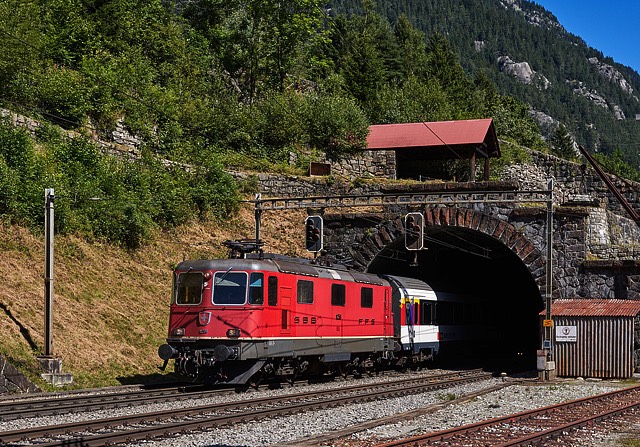
Total expenditure on transport was just over CHF200 including the rail fares from Zürich Flughafen to Göschenen and back from Erstfeld. An 8 day Swiss Pass would have been CHF363, not far off double the price I paid. The buses were convenient and generally punctual, more than could have been said for the trains. It should be noted that while the buses connect with trains at Faido and Erstfeld, they don’t wait more than a few minutes if the train is late.
Travel from the UK was with Swiss from Heathrow to Zürich and back with an early arrival at Zürich on the way out and a punctual return to the new Terminal 2 at Heathrow.
I stayed at the Hotel Weisses Rössli in Göschenen, a bit expensive at CHF95 a night, including a good breakfast buffet from 07:30 and free WiFi. It is, however, a very pleasant and comfortable place to stay and very convenient for the station. The hotel was arranged through booking.com although you can reserve a room via their own website (in English) https://www.weisses-roessli.com.
Travel from the UK was with Swiss from Heathrow to Zürich and back with an early arrival at Zürich on the way out and a punctual return to the new Terminal 2 at Heathrow.
I stayed at the Hotel Weisses Rössli in Göschenen, a bit expensive at CHF95 a night, including a good breakfast buffet from 07:30 and free WiFi. It is, however, a very pleasant and comfortable place to stay and very convenient for the station. The hotel was arranged through booking.com although you can reserve a room via their own website (in English) https://www.weisses-roessli.com.
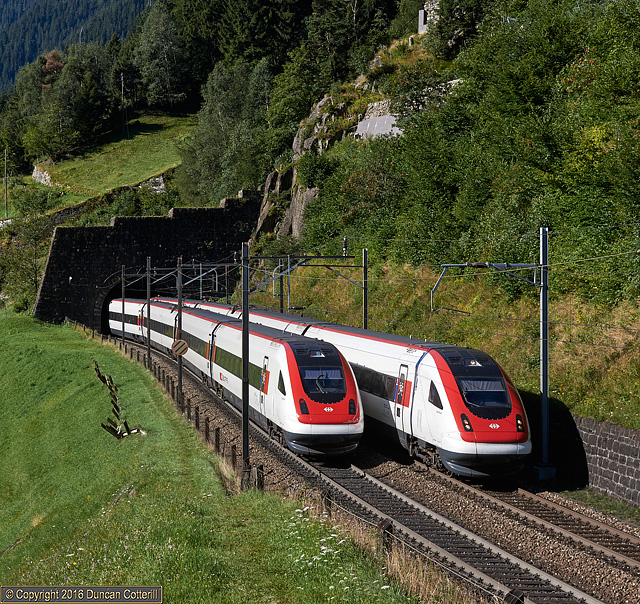
A Diet Of Worms
There were more tilting EMUs on the Gotthard than either loco hauled passenger trains or freights. At times it seemed there was practically nothing else about and every time a signal turned green it would be a RABDe500 or an RABe503 that appeared shortly afterwards. After a while I got thoroughly fed up of the things.Two white worms slithered past each other high above Wassen on the morning of 14 August 2016. 500.016 on the right was working ICN 886 from Chiasso to Zürich past an unidentified RABDe500 on ICN 873 from Zürich to Lugano.
AN AFTERNOON AT ZÜRICH HB
The plan for the last afternoon of the trip was to take my luggage down to Erstfeld and leave it in a locker before returning to Amsteg for an afternoon’s photography. When I got there and discovered that there weren’t any lockers, the next best option seemed to be to continue to Zürich HB and spend the late afternoon photographing there. The light would be on the front of anything leaving and there were over a dozen departing trains booked for Re4/4II haulage between 16:00 and 18:45, when I had to leave for the airport. There would also be plenty of departures with Class Re460s but most of those would be propelled out and I had little information on which trains would have the loco on the front.
As long as the sun shone, it should have been a turkey shoot but turned out to be anything but. I’d assumed that around half the hauled departures would leave from even numbered platforms but only three did, and only one of them was Re4/4II hauled. All the rest went from odd numbered platforms, meaning that they were on the nearest track and not so good for photography.
It was easy enough to watch the trains coming in from the end of a platform in the middle of the station, identify any that didn’t have a driving trailer at the back and then use the Sihlquai underground passage to get to the right platform for the departure shot. There were even up and down escalators so dragging luggage around wasn’t too much of a hassle.
Most of the expected trains produced but there was the odd Re4/4II on a train I hadn’t expected and the odd RE460 on a train booked for an Re4/4II.
Wrong Platform?
11144 left Zürich HB with IC 182, the 16:35 to Stuttgart Hbf, on the afternoon of 14 August 2016. At the back 11155 can just be seen, waiting to be released for its next duty.In common with most Re4/4II hauled departures that afternoon, this train left from an odd numbered platform meaning the only photo possible was from a fairly head on angle, not that I could reasonably complain in this instance.

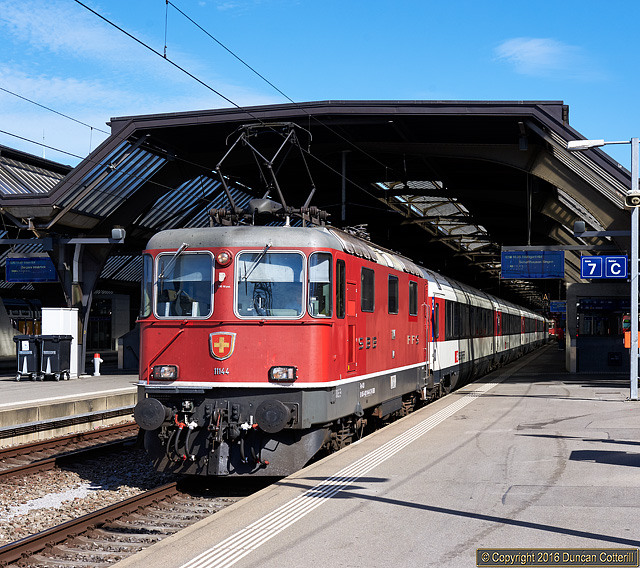
COMMENTS & CONCLUSIONS
Overall not a bad trip with plenty of sunshine, provided you went where the sun was shining rather than where you wanted to go. Traffic levels were a bit disappointing by Gotthard standards but would have stood up well when compared to most other main lines in Europe. There was enough variety as well with four operators working freight trains over the route using several classes of loco, two types of loco on the IR trains and two different types of tilting EMU on EC and ICN services.
The closely spaced electrification masts do make photography more difficult than on most mountain main lines but they’re an annoyance, rather than a showstopper. That said, the scenery continues to be superb and more than makes up for any shortcomings on the pole front.
After not finding any left luggage lockers at Erstfeld and noticing that there were none at Göschenen either, I had a look on the SBB website and found that the information is available there, for all stations in Switzerland, not only the SBB ones. https://www.sbb.ch/en/station-services.html.
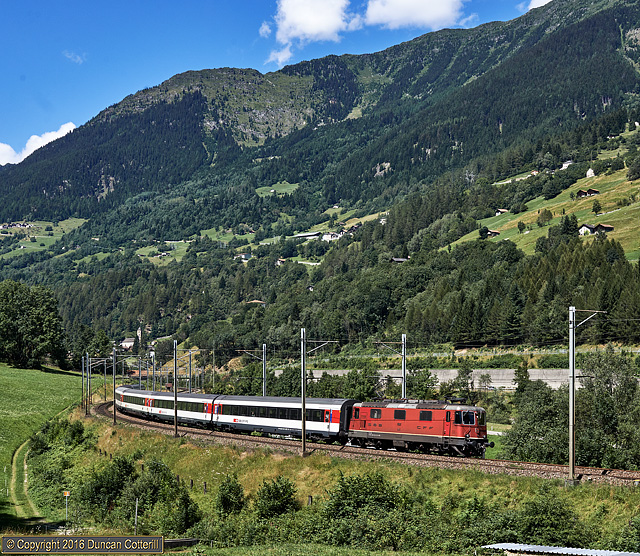
Feeling Better
After failing on my train from Zürich to Göschenen a few days earlier, 11197 was feeling better by 11 August when it worked IR 2421, the 12:09 from Zürich HB to Locarno, past Varenzo, south of Ambri-Piotta. However, like many of the SBB locos seen on the trip, it would have benefitted from a good wash.This was my first visit to Switzerland for a few years and I was surprised by the number of loco failures and substitutions, train cancellations and the extent of late running, not just on trains with connections from Italy. As somebody who regarded the Swiss system as a shining example of a reliable, efficient and well run railway, my faith was more than a bit shaken.
The official opening of the new Gotthard Base Tunnel attracted a lot of publicity and seems to have been celebrated in Switzerland as something universally wonderful, with huge demand to ride one of the first trains through the hole. Personally, I can’t see what all the fuss is about. A tunnel is a tunnel. The experience must be very similar to any other tunnel except that there’s no view from the window for a longer period than usual. It might be useful for business travellers to reach Bellinzona more quickly and efficient for freight train operators to move more tonnage with fewer locomotives but, as an experience, it has to rank as one of the most tedious on the planet.
Unfortunately, from December, the base tunnel will be the default method for rail travellers to reach Ticino and the fabulous experience of travelling over the old main line with its views of magnificent alpine scenery will only be available to those determined enough to seek it out. The decision to provide a passenger service over the old line by extending the local service north from Biasca to Erstfeld means that there will be no direct connections with trains from Luzern, Zurich or Basel. Travellers from the north will have to connect with a local train to Erstfeld at Zug or Arth-Goldau and then change again at Erstfeld, hardly an incentive to travel.
BLS seems to have made a go of the old Lötschberg main line since that base tunnel opened, introducing hourly direct trains between Bern and Brig that connect with IC services from Zürich, Basel, Lausanne and Genève and serve all the stations on the old line. In my experience the Lötschberg trains were well patronised, justifying the service. BLS also has the lucrative car shuttle business through the old Lötschberg Tunnel and the line is open to freight operators with locos not equipped to run through the base tunnel. All this must make a significant contribution to the upkeep of some very expensive infrastructure.
SBB, on the other hand, don’t really seem interested in the Gotthard. They’ve made the old main line inaccessible to traction not equipped with ECTS by taking out the conventional signals on the section from Brunnen through Altdorf used by trains on both the old and new routes. And they’re planning to introduce a passenger service that will be difficult for most travellers to use, actively dissuading all but the most determined. You have to wonder whether this is a Beechingesque attempt to make the old line grossly uneconomic so they can close it.
Unfortunately, from December, the base tunnel will be the default method for rail travellers to reach Ticino and the fabulous experience of travelling over the old main line with its views of magnificent alpine scenery will only be available to those determined enough to seek it out. The decision to provide a passenger service over the old line by extending the local service north from Biasca to Erstfeld means that there will be no direct connections with trains from Luzern, Zurich or Basel. Travellers from the north will have to connect with a local train to Erstfeld at Zug or Arth-Goldau and then change again at Erstfeld, hardly an incentive to travel.
BLS seems to have made a go of the old Lötschberg main line since that base tunnel opened, introducing hourly direct trains between Bern and Brig that connect with IC services from Zürich, Basel, Lausanne and Genève and serve all the stations on the old line. In my experience the Lötschberg trains were well patronised, justifying the service. BLS also has the lucrative car shuttle business through the old Lötschberg Tunnel and the line is open to freight operators with locos not equipped to run through the base tunnel. All this must make a significant contribution to the upkeep of some very expensive infrastructure.
SBB, on the other hand, don’t really seem interested in the Gotthard. They’ve made the old main line inaccessible to traction not equipped with ECTS by taking out the conventional signals on the section from Brunnen through Altdorf used by trains on both the old and new routes. And they’re planning to introduce a passenger service that will be difficult for most travellers to use, actively dissuading all but the most determined. You have to wonder whether this is a Beechingesque attempt to make the old line grossly uneconomic so they can close it.
Missed Opportunity?
11200 passed the closed station at Wassen with IR 2422, the 10:47 from Locarno to Basel, on 13 August 2016.If SBB got their act together, scenes like this needn’t be consigned to history and trains could even stop at Wassen and other stations for the first time in decades. If marketed properly, some of the high costs of maintaining the infrastructure could be offset by attracting more passengers to the line, rather than deterring them with poor services and ropey connections.
Don’t hold your breath though, SBB shows no sign of realising the tourist potential of a line that runs through some of Europe’s most spectacular scenery.
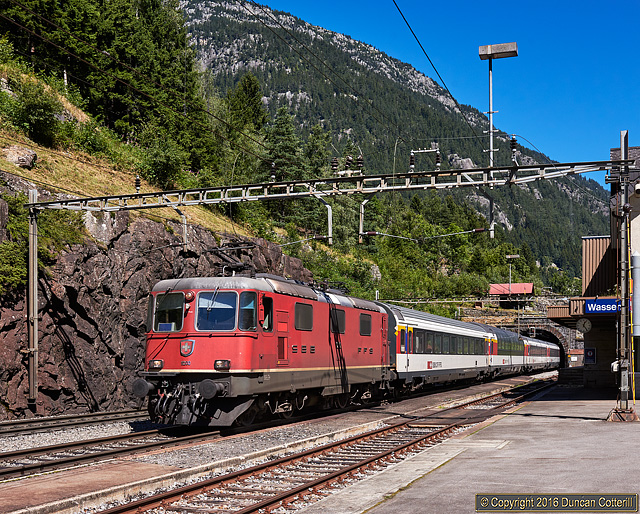
A passenger service from Arth-Goldau to Bellinzona, connecting with expresses from Zürich and Basel and serving the same stations as the current IR trains would be a big improvement on what’s currently planned and far more attractive to potential travellers. There’s scope for further improvements, such as extending the train to Luzern and stopping at more places on the Gotthard, such as Amsteg-Silenen, Gurtnellen, Wassen, Ambri-Piotta, Rodi-Fiesso and Bodio. There must also be a case for a car shuttle through the old Gotthard Tunnel. It differs from the Lötschberg by being paralleled by a motorway but that motorway is usually choked with traffic and the queues for the tunnel have to be seen to be believed. In some ways a shuttle from Erstfeld to Biasca would make more sense than a short run through the tunnel as it would bypass the queues either side of the road tunnel as well as the tunnel itself, it would also justify higher charges and provide loco hauled trains to photograph. BLS operate similar services between Kandersteg and Iselle, so why don’t SBB at least try it?
As things stand currently, I’ve probably made my last trip to the Gotthard. It’s certainly not worth going back for the few EMUs that will be on offer from December. I’m tempted to go back in September for a handful of shots that eluded me this time but, at current exchange rates, it would be a very expensive way of getting not very many pictures. The freights will continue to use the existing route north and south of the new tunnel so future visits to those lines are possible but they’re not high on the agenda.
The Gotthard Base Tunnel will make the world a less interesting place. I’m glad I photographed the old line while it was reasonably busy but it was hard work to get the best out of it. Time to move on to somewhere else, preferably without so many poles to get in the way.
Finally, thanks to the diagram compilers and those who supplied information or published reports or pictures. It all helps to understand what’s going on and make the most of it. Keep up the good work.
As things stand currently, I’ve probably made my last trip to the Gotthard. It’s certainly not worth going back for the few EMUs that will be on offer from December. I’m tempted to go back in September for a handful of shots that eluded me this time but, at current exchange rates, it would be a very expensive way of getting not very many pictures. The freights will continue to use the existing route north and south of the new tunnel so future visits to those lines are possible but they’re not high on the agenda.
The Gotthard Base Tunnel will make the world a less interesting place. I’m glad I photographed the old line while it was reasonably busy but it was hard work to get the best out of it. Time to move on to somewhere else, preferably without so many poles to get in the way.
Finally, thanks to the diagram compilers and those who supplied information or published reports or pictures. It all helps to understand what’s going on and make the most of it. Keep up the good work.
